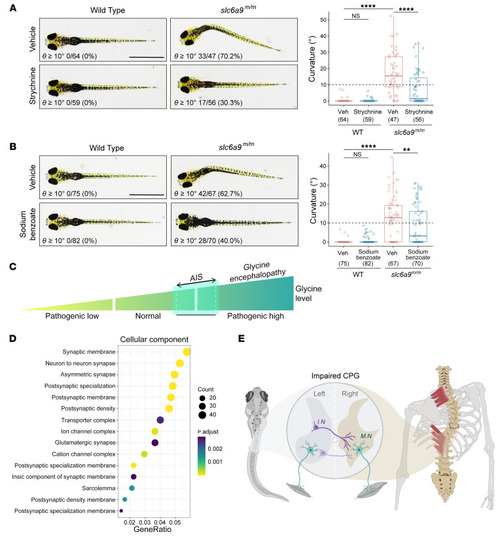|
Prevention of body curvature in slc6a9 mutant zebrafish by pharmacological intervention. (A) Representative dorsal-view images of axial phenotypes of WT and slc6a9m/m larvae treated with vehicle or strychnine (GlyR antagonist, 0.5 μM). (B) Representative dorsal-view images of axial phenotypes of WT and slc6a9m/m larvae treated with vehicle or sodium benzoate (glycine neutralizer, 0.5 ppm). Scale bars: 1 mm. In A and B, the number of analyzed fish and the penetrance of curvature are quantified and indicated for each genotype. Boxes show the median and IQRs with all individual data points superimposed. One-way ANOVA test. **P < 0.01; ****P < 0.0001. (C) Proposed glycinopathy spectrum. Abnormally high levels of glycine are associated with glycine encephalopathy, a severe neurological disease, whereas moderately elevated levels of glycine are a causal risk factor for AIS. (D) Cellular component of GO functional enrichment analysis of AIS-associated genes. GeneRatio is the ratio of genes mapped to a pathway to the total gene set. The size of the dots represents the number of genes mapped to the pathway. (E) Proposed disease mechanism of spinal curvature. In zebrafish, disruption of glyt1 causes a discoordination of left-right neural activities in the spinal cord due to aberrant glycinergic neurotransmission; deletion of dmrt3a partially impairs the development of commissural interneurons and compromises the locomotor left-right alternation; both lead to an AIS-like phenotype via the disturbance of CPGs in the spinal cord. In humans, functional impairment of GLYT1 leads to elevated glycine levels, aberrant paraspinal muscle activities, and AIS. Our findings suggest that dysfunction of the CPGs induced by either excessive glycine or developmental defects is one of the major causal factors underlying the etiology of AIS. I.N., interneurons; M.N., motoneurons.
|

